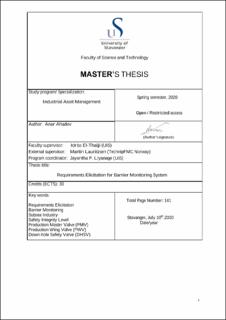| dc.contributor.author | Ahadov, Anar | |
| dc.date.accessioned | 2020-09-20T18:21:40Z | |
| dc.date.available | 2020-09-20T18:21:40Z | |
| dc.date.issued | 2020-07-10 | |
| dc.identifier.uri | https://hdl.handle.net/11250/2678606 | |
| dc.description | Master's thesis in Industrial asset management | en_US |
| dc.description.abstract | The activities undertaken by operator companies in the Norwegian Continental Shelf pose a very high risk to human life and the environment. Leading causes of accidents are poor maintenance, inadequate risk assessment and failure of barrier safety valves. A combination of all the listed accident causes are investigated with a focus on barrier valves (PMV, PWV, DHSV). Despite the fact that PSA has defined regulations and recommended standards related to barriers managements, operators in the Norwegian continental shelf still fail to implement the regulatory requirements regarding safety barriers. This stems from challenges related to interpretation and uncertainty of barrier testing requirements.
Challenges related to interpreting barrier requirements arise from terminological inconsistencies or the use of non-standard syntax in documenting requirements. The
purpose of this study was to illuminate the challenges encountered by operator companies in adhering to standards recommended by Petroleum Safety Authority of Norway. There will be a focus on clarity of testing requirements from standards, technical challenges which prevent standard adherence and technical capabilities of current condition monitoring systems.
To understand how these requirements and generate primary data, semi-structured interviews (with customers or via representative) were performed to get specific clarification and standard based requirements, customer-based requirements are analyzed and verified. Secondary data was also collected and analyzed from di erent case studies.
The requirements elicitation discovered that companies preferred to follow NOR-SOK D-10 as opposed to PSAN recommendation of NOG 070, since NOG 070 gives little weight to uncertainties during PFD calculation. Commonest failure modes cited during valve failure were mechanical failure due to leakage, general mechanical failure and corrosion. Findings also suggested that operator companies did not follow the maintenance procedure strictly. Also, condition monitoring systems provided by monitoring service providers did not could not detect certain failure modes that operators faced. | en_US |
| dc.language.iso | eng | en_US |
| dc.publisher | University of Stavanger, Norway | en_US |
| dc.relation.ispartofseries | Masteroppgave/UIS-TN-IMBM/2020; | |
| dc.subject | industrial asset management | en_US |
| dc.subject | driftsledelse | en_US |
| dc.subject | requirements elicitation | en_US |
| dc.subject | barrier monitoring | en_US |
| dc.subject | subsea industry | en_US |
| dc.subject | safety integrity level | en_US |
| dc.title | Requirements Elicitation for Barrier Monitoring System | en_US |
| dc.type | Master thesis | en_US |
| dc.subject.nsi | VDP::Teknologi: 500 | en_US |
| dc.source.pagenumber | 141 | en_US |
